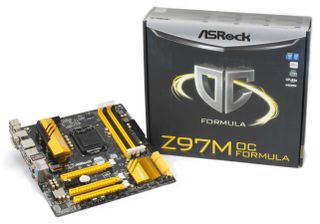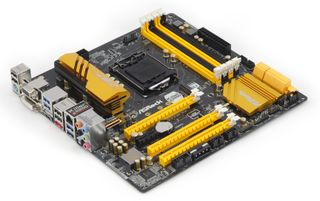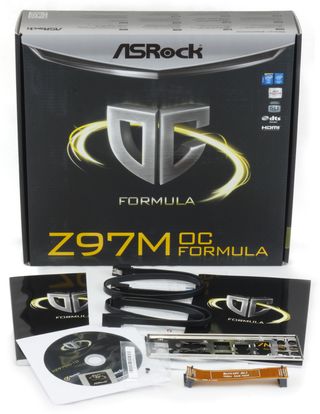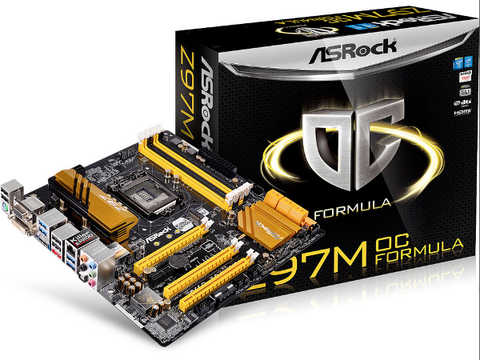Early Verdict
The Z97M OC Formula gives you all the tools you need for a capable and robust system in the mATX form factor.
Pros
- +
Big VRM and even bigger VRM heatsink • Robust overclocking UEFI, SLI and CFX support • M.2 slot • SATA Express • eSATA • Killer network • DTS-Connect • Five fan headers • Thunderbolt capability
Cons
- -
Automatic secondary and tertiary RAM timings at DDR3-2800 impair RAM performance • No onboard power buttons • No debug display • No voltage testing points • No CMOS reset button
Why you can trust Tom's Hardware
Specifications & Overview

ASRock typically reserves the OC Formula moniker for the company's top overclocking models, so I'm curious to see if this board can live up to its name. The smaller mATX form factor doesn't necessarily mean the power circuitry up top is compromised, so there's no reason this board shouldn't post some impressive numbers — in theory. While it retails for $136, you can often find it selling for as low as $125. The board proudly claims it was designed by overclocker Nik Shih, so let's see if it's worth the price of admission.
Specifications
Overview
ASRock uses three primary color schemes for its motherboards. Blue is the default color while the many Fatal1ty models get a red/black treatment. Only the OC Formula line gets the gold/black scheme, and today's contestant boasts it proudly. It doesn't count toward my recommendation, but I have to admit the board looks sharp.

The OCF is definitely a step or three above the recently reviewed Pro4. In addition to what you find on ASRock's cheaper offering, the OCF includes a more robust VRM, full SLI support (and meaningful CrossFireX), a Killer network controller, SATA Express, an M.2 slot and a few extra tidbits. Time for a detailed look.

Let's get the basic stuff out of the way. The 8-pin EPS power plug at top delivers plenty of power for CPU overclocking. Managing that power delivery is an 8+2-phase VRM under a sizeable heatsink. The heatsink may look the same as the one on the Pro4, but it's substantially thicker, with more fins and exposed surface area for passive cooling. A 3- and a 4-pin fan header for CPU cooling are next to the four RAM slots. Down the front edge is the usual 24-pin power plug, USB 3.0 header and six forward-facing SATA ports. A single SATA Express port joins the regular SATA connectors. The SATA Express port, fifth and sixth SATA ports, and the M.2 slot all share the same PCIe lanes, meaning you can only use one of them at a time (or both regular SATA ports).
The M.2 slot itself supports 30mm, 42mm, 60mm and 80mm modules (type 2230, 2242, 2260 and 2280, respectively). It can function in either regular SATA 6.0 Gbps mode or PCIe mode (up to 2.0 x2 at 10 Gbps). The slot is located above the first PCIe slot, which I prefer. An M.2 drive below the main PCIe slot is susceptible to GPU waste heat, particularly GPUs with axial fans and cooling fins running perpendicular to the motherboard. According to our storage expert, Chris Ramseyer, this has two problems. First, many new M.2 drives will throttle when hot, with 70 to 80 degrees Celsius being the threshold. He's seen speeds drop down to 100-150 MB/s sequential read or write in those situations. The second, and much bigger issue, is the flash wearing out faster. TLC flash has about 1,000 to 1,500 P/E cycles. That's a decent lifespan under normal use. However, Chris says flash can experience three times the wear when data is written to it at temps of 80 degrees C or more.
To the left of the M.2 are two more 3-pin fan headers and the Atheros Killer E2200 network controller. Just behind the rear audio jacks is the HD audio header, which is powered by ASRock's Purity Sound 2 package. This includes Realtek's ALC1150 codec, including DTS-Connect providing real-time DTS encoding for 5.1 audio over S/PDIF. You also get premium audio caps, 115dB SNR and a TI NE5532 amp that can drive 600-ohm headphones.
The OCF has four add-in card slots. The first and third slots wired to the CPU's PCIe 3.0 lanes in a x16/x0 or x8/x8 configuration, meaning official Nvidia SLI support. Between them is a PCIe 2.0 x1 slot (which will likely never be used due to double-slot GPUs), the CMOS battery and a socketed BIOS chip for replacement. The bottom slot is only wired for four lanes and uses the chipset's slower 2.0 signaling.
The headers across the bottom include a typical mix of a serial port, two USB 2.0 headers, TPM, case speaker, another 4-pin fan header, front panel connectors, a CLR CMOS jumper and a Thunderbolt header. Using the Thunderbolt requires a separate add-in card. Between the serial and USB headers is a down-facing 4-pin Molex power plug. This is for additional power to the PCIe slots when using multiple GPUs, especially high-draw cards. The manual says to use the plug when using more than three GPUs. Of course, this board can't handle more than three GPUs — really it can't handle more than two.

The I/O backplate packs a few nice extras compared to lesser boards. The OCF has a PS/2 jack and four USB 2.0 ports (two more than on the Pro4) for your peripherals. I'm a sucker for an eSATA port, and the OCF adds one to join the four USB 3.0 ports for high-speed data transfer. The eSATA is capable of 6.0 Gbps and shares the same lane as the second internal SATA controller. Onboard video is handled by VGA, DVI-D and HDMI ports. The aforementioned Killer network controller powers a single Ethernet jack, while five 3.5mm analog and one optical TOSLINK jacks feed into the Purity Sound 2 system.

The OCF comes in some premium packaging. Instead of a thin foam sheet in an anti-static bag, the OCF is wrapped in and zip-tied to high-density foam. The included manual goes into more detail than you usually find. Other inclusions in the box are a flexible SLI bridge, I/O backplate shield, quick start guide, installation CD, M.2 mounting screw and two SATA cables (one angled connector). A board of this caliber really deserves four SATA cables, so having only two is a little disappointing. On the other hand, the M.2 slot means you don't need a cable when installing a SSD drive, so the dearth of cables is easier to take.
Altogether that's a fairly loaded motherboard. A few lacking features stand out on a board designated as "OC Formula." The biggest omissions are an internal debug display, voltage testing points, bench-friendly power and reset buttons, a CLR CMOS button, and maybe dual BIOS. On a board costing $136, I don't expect all of these to be present, but one or two would have been nice.
It's worth noting that the full ATX version of the OCF has all of these features and more (such as a beefier 12+4-phase VRM and two extra SATA ports). That board also sells for $200 or more. I'm willing to bet ASRock trimmed a few of those features to better differentiate the full-size and mATX models and prevent sales cannibalism. That's understandable. Still, to be considered a top-level overclocking board, I think it needs at least a debug display, CMOS reset button and voltage detection points. If that means the price jumps up $5, I'm willing to pay that, and I think most enthusiasts would be too.
MORE: Best MotherboardsMORE:
How To Choose A Motherboard
MORE: All Motherboard Content
-
Blueberries This is one of my favorite motherboards. Extremely good quality and probably the best value you can get for the Z97 chipset.Reply -
DonkeyOatie I spent many hours of harmless fun over the Summer overclocking everything I could get my hands on on this board. I learned a lot and still have much pre to learn, especially about getting my Trident X past 2800Mhz.Reply
http://www.tomshardware.com/forum/id-2626627/build-log-middle-school-science-fair-project-system.html
I think this is the best price/performance board for SLI/Overclockng. It is often available at under $100 from Newegg, due to a manufacturer's rebate. Putting it in a Thermaltake Core V21 made the built and 'putzing' process -
RedJaron I'd recommend you test RAM bandwidth at each frequency strap to find the best actual performance. As I found with this board ( and others ), the auto-settings for secondary and tertiary timings can do weird things. It's not uncommon for a board to go with looser auto-timings just so they can say they support faster RAM. Even though I could reach DDR3-2900 on this board, it actually performed worse than 2400 because of looser timings. Now if you're the type of person that manually sets every single RAM timing, this may not be an issue. However I don't have that much time when reviewing boards.Reply -
DonkeyOatie Reply16776633 said:I'd recommend you test RAM bandwidth at each frequency strap to find the best actual performance. As I found with this board ( and others ), the auto-settings for secondary and tertiary timings can do weird things. It's not uncommon for a board to go with looser auto-timings just so they can say they support faster RAM. Even though I could reach DDR3-2900 on this board, it actually performed worse than 2400 because of looser timings. Now if you're the type of person that manually sets every single RAM timing, this may not be an issue. However I don't have that much time when reviewing boards.
I started auto, but needed to adjust things by hand. There are so many possibilities and combinations, it gets a bit mind-boggling. The whole thing was a great learning experience for me and something I would strongly recommend to anyone so inclined. -
Onus Nice review. I like the smaller size, but this is probably not the board for me, since I'm not a die-hard tweaker; I just want thing to work, although a little extra "go fast" is welcome.Reply -
DonkeyOatie Whereas for my Middle School student who is doing a Science Fair project on it investigating simple CPU and memory overclocking, it is just the right thing (and cheap enough in case things turn pear-shaped)Reply -
JacFlasche I am getting ready for my next build: waiting for the improved skylakes at the end of October, and hoping there will be more than one board that provides integral Thunderbolt 3 connections. I would really like to see a review on the Gigabyte Z170X-UD5 TH. Which is the only MB that has it at present. I gather that Asus is going to offer an expansion card with it, but not with an intel chip. I guess I would consider a board and a Thunderbolt 3 expansion card if everything else was right, depending on the brand and speed of the chip on the card.Reply
I am kind of surprised at the lack of interest in Thunderbolt 3. I move files of ten or more GB to external storage all the time, but beyond the unparalleled speed, the one connector to rule them all idea is great. My next board, gotta have it, along with USB 3b or whatever is the latest. Couldn't care less about SATA Express.
I am almost tempted to build another notebook and connect it to external video cards -- almost. Now if someone would just dump a bunch of the latest MSI whitebooks on ebay it would be a definite maybe, but only if they had a Thunderbolt 3 connection. At this point I would not even consider a notebook without it, and my guess is that when people realize the potential it provides they will wish they had it. Maybe I am just a victim of hype, but in this case I kind of doubt it. -
utroz To the author: Page 2 middle of the page.Reply
"Two modules were much more flexible and reached DDR2-2884 at a 103MHz BCLK."
Shouldn't this say DDR3-2884 not DDR2-2884?
Just trying to help..

